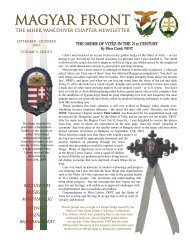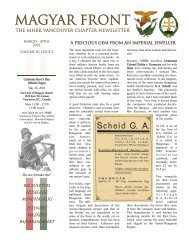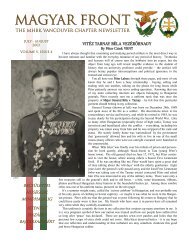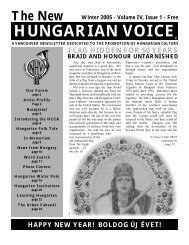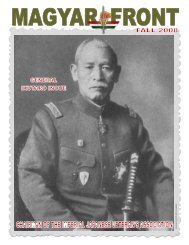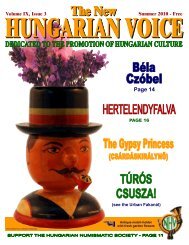THE NEW HUNGARIAN VOICE FALL 2003 (Read-Only)
THE NEW HUNGARIAN VOICE FALL 2003 (Read-Only)
THE NEW HUNGARIAN VOICE FALL 2003 (Read-Only)
Create successful ePaper yourself
Turn your PDF publications into a flip-book with our unique Google optimized e-Paper software.
LEARNING <strong>HUNGARIAN</strong><br />
Vocabulary:<br />
ott - there mi - what ki - who<br />
az - that (a different word than the definite article, but looks and sounds the same)<br />
ez - this köszönöm - thank you mi a neve - what's your name (polite)<br />
a nevem... - my name is… asztal - table pincér (remember c is 'ts') - waiter jól - well<br />
hol - where is - also hogy - how egy - a, an, one autó - car<br />
Some sample sentences:<br />
Mi az What is that<br />
Ez egy autó és az egy asztal. This is a car and that is a table.<br />
Köszönöm, jól vagyok. Thank you, I am good. (well)<br />
Hol a pincér Ott. Where is the waiter There.<br />
Grammar - The Indefinite Article<br />
The indefinite article in Hungarian is egy, which also means ‘one’. However, it is used less frequently<br />
than in English. Look at the following sentences:<br />
Ő turista. He is (a) tourist. Egyetemista vagyok. I am (a) student.<br />
In the above sentences, the article is required in English, but not in Hungarian. You will get a feel of when<br />
to use the article once you have been exposed to more sentences and had some practice.<br />
Ez and Az<br />
The Hungarian words ez and az correspond to English ‘this’ and ‘that’ respectively, in the context of<br />
both ‘that book is good’ and ‘that is a book’ (French, for example, makes a difference between ‘that’ in these<br />
two contexts). When ez or az is modifying the noun, as in ‘that book’, the Hungarian noun must be<br />
preceded by the definite article a or az. Examine the following sentences:<br />
Ki ez Who's this<br />
Ez az autó szép. This car is pretty.<br />
Az az autó is szép. That car is also pretty.<br />
Ez az asztal. This is the table.<br />
Note: Ez az asztal can mean ‘this is the table’ or ‘this table…’ but here it must be the former because the<br />
latter is not a complete sentence.<br />
Greetings:<br />
Jó reggelt (kívánok) Good morning<br />
Jó napot (kívánok) Hello (formal, literally 'good day')<br />
Jó estét (kívánok) Good evening<br />
Jó éjszakát (kívánok) Good night<br />
Note: the above expression are both formal and informal. The ‘kívánok’ is optional and slightly more formal.<br />
With kívánok, the expressions mean ‘I wish you good morning’, etc.<br />
A viszontlátásra Goodbye (formal)<br />
Szervusz (Szervusztok to more than one person) Hello/Goodbye (informal)<br />
Szia (Sziasztok to more than one person) Hello/Goodbye (more informal)<br />
Hogy van How are you (formal)<br />
Hogy vagy How are you (informal)<br />
Note: When you ask Hogy vagy in Hungarian, you are really asking how they are, unlike in English where<br />
‘how are you’ is a polite greeting. A good answer to the question would be: Jól vagyok, ‘I am fine (well)’.<br />
LESSONS CONTINUED IN <strong>THE</strong> NEXT ISSUE!<br />
Hungarian Language Course on the Internet: http://www.people.fas.harvard.edu/~arubin/hungarian.html<br />
16





